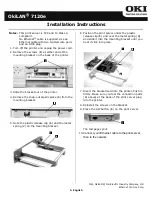
Table 13. Memory operating modes
Memory Operating Mode
Description
Optimizer Mode
The
Optimizer Mode
if enabled, the DRAM controllers operate
independently in the 64-bit mode and provide optimized memory
performance.
Mirror Mode
The
Mirror Mode
if enabled, the system maintains two identical
copies of data in memory, and the total available system memory is
one half of the total installed physical memory. Half of the installed
memory is used to mirror the active memory modules. This feature
provides maximum reliability and enables the system to continue
running even during a catastrophic memory failure by switching
over to the mirrored copy. The installation guidelines to enable
Mirror Mode require that the memory modules be identical in size,
speed, and technology, and they must be populated in sets of 6 per
processor.
Single Rank Spare Mode
Single Rank Spare Mode
allocates one rank per channel as a spare.
If excessive correctable errors occur in a rank or channel, while the
operating system is running, they are moved to the spare area to
prevent errors from causing an uncorrectable failure. Requires two
or more ranks to be populated in each channel.
Multi Rank Spare Mode
Multi Rank Spare Mode
allocates two ranks per channel as a spare.
If excessive correctable errors occur in a rank or channel, while the
operating system is running, they are moved to the spare area to
prevent errors from causing an uncorrectable failure. Requires three
or more ranks to be populated in each channel.
With single rank memory sparing enabled, the system memory
available to the operating system is reduced by one rank per
channel.
For example, in a dual-processor configuration with 24x 16 GB dual-
rank memory modules, the available system memory is: 3/4 (ranks/
channel) × 24 (memory modules) × 16 GB = 288 GB, and not 24
(memory modules) × 16 GB = 384 GB.
For multi rank sparing, the multiplier changes to 1/2 (ranks/
channel).
NOTE:
To use memory sparing, this feature must be
enabled in the BIOS menu of System Setup.
NOTE:
Memory sparing does not offer protection against a
multi-bit uncorrectable error.
Dell Fault Resilient Mode
The
Dell Fault Resilient Mode
if enabled, the BIOS creates an area
of memory that is fault resilient. This mode can be used by an OS
that supports the feature to load critical applications or enables the
OS kernel to maximize system availability.
70
Installing and removing system components
















































